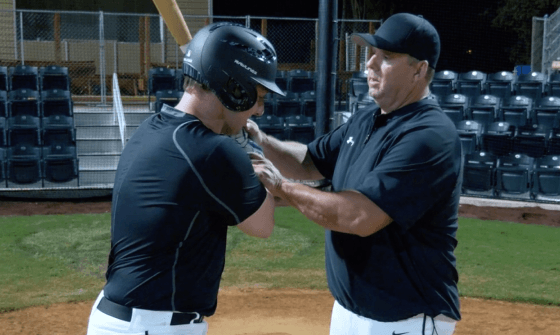Ty Cobb, one of the greatest hitters (and least-liked players) of all time was an early advocate of choking up (moving the hands up the handle of the bat an inch or so), and it was actually on a published list of his batting tips. He was quoted as saying, “Don’t grip your bat at the very end. Leave at  least an inch or two.” By choking up, and also leaving a gap between his hands on his grip, Cobb felt he had more control of the baHe wasn’t after big blasts and wasn’t swinging for the fences—he was trying to get hits. And get hits he did, hitting .400 three times over his long career.
least an inch or two.” By choking up, and also leaving a gap between his hands on his grip, Cobb felt he had more control of the baHe wasn’t after big blasts and wasn’t swinging for the fences—he was trying to get hits. And get hits he did, hitting .400 three times over his long career.
That was then. This is now.
Today, only a handful of players are known to choke up on the bat, and if they do, it’s usually only with a two-strike count, or with the game on the line.
There is one major exception: Believe it or not (and you may find this very hard to believe), Barry Bonds—the greatest home run hitter of all time by the numbers—choked up on the bat. He claimed he did it for greater bat control and even claimed that by using less of the handle, he got more of the barrel to work with.
It must have worked (forgetting about other ingredients that might have been in play, for now.)
But today, choking up on the bat is somewhat of a dying art. Sure, you’ll still see some hitters choke up on the bat (and maybe shorten their swing) with two strikes on them, or if there’s a runner who needs to be moved over a base. When they do, they’ve put power on the back burner, and put bat control into play.
But that’s not what gets the ball over the fence, or gets you a fat contract, or what you’re going to see when you go to most ballgames.
All-Stars hit home runs, don’t they?
Think about it: The day before the All-Star Game, Major League Baseball holds its annual Home Run Derby…not the Punch-and-Judy-Hitter Derby, or the Banjo Hitter Brigade. Fans want to see the ball fly over the fence. They want to see bombs and taters and dingers, not Texas Leaguers.
Choking up on the bat is going the way of the spitball and stirrups. Maybe that’s why, year after year, the number of strikeouts continues to grow. It’s all about the big hit (and the big swing), not just about a timely hit by someone choking up on the bat.
What do hitting coaches think?
Getting hitters to think about choking up is a losing battle, and hitting coaches know it. Derek Shelton, hitting coach for the Tampa Bay Rays, summed it up: “Now you’re seeing what guys want to do is hit the ball out of the ballpark. So you see bigger swings and more strikeouts.”
The statistics bear that out. The average number of strikeouts per game, around 7.5, is twice what it was in the ’40s and ’50s, according to Baseball Reference.com.
“In the ’50s and ’60s, if you had a guy strike out 100 times in a season, it was unbelievable,” Shelton said. How things have changed. Most hitting coaches think that striking out is seemingly a forgivable sin these days, if the player comes through now and then with a homer or a timely bases-clearing or game-winning hit.
Here’s proof of that: In 2014, Ryan Howard of the Phillies led the league with 190 strikeouts. The Angels’ Mike Trout led the American League with 184…and he won the MVP title.
Brook Jacoby, who will be the Blue Jays’ new hitting coach in 2015, cites the numbers to back up his theory. “Nearly half of the at-bats get to two strikes,” he said, “but few hitters shorten their swings or their grips for contact. The game’s built around power now. Parks are smaller. The accountability is different.”
In the past decade, most hitters have gone to great lengths to get stronger and bigger, from using the weight room, to special diets, to pushing the boundaries of health supplements…Bonds, Sammy Sosa and Mark McGuire all have questionable credentials.
Equipment change.
Even though they’re still made out of wood, baseball bats have changed and have also affected hitters’ swings. Go to a sports museum and take a look at the thick-handled bats from the ’30s and ’40s. Then look at the bats used by Babe Ruth, Jackie Robison or Lou Gehrig. Ruth once used a 54-ounce bat in his early days. He used a 40-ounce bat in 1927 when he hit 60 home runs.
You won’t find pieces of lumber like that in today’s dugout. Tony Gwynn found his groove when he switched to a lighter bat, as light as 30.5 ounces.
That’s one reason players don’t choke up, says Merv Rettenmund, former player and MLB hitting coach for twenty years. “No one uses the big bats or the big handles anymore. They’re light, light bats. If some of these guys choked up, they’d have nothing left.”
Do any batters come to mind when you think of hitters who choked up? Here are a few: Nellie Fox, Rod Carew, Ty Cobb, Hunter Pence, and Joey Votto, the National League MVP in 2010. And believe it or not, Bucky Dent hit his Red Sox-killing home run in 1978 while choking up a few inches on the bat.
Ask Boston fans what they think of his shortened swing and the result…but cover your ears when they say his name!

